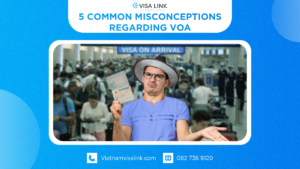Planning a trip to Vietnam? If so, you’ve likely encountered the term “Visa On Arrival” (VOA). While this option can be convenient, it’s often surrounded by misconceptions. Let’s address some common misunderstandings to help you make an informed decision.
1. Visa on arrival can be simply obtained at the airport when traveling to Vietnam
Many people believe that a visa can be conveniently obtained upon arrival at Vietnam’s airport, making it a hassle-free process. While this is true for citizens of specific countries, it’s important to understand that airlines often enforce stricter regulations. To avoid unexpected complications and potential delays, such as being denied boarding, travelers are strongly advised to secure a visa before embarking on their journey to Vietnam. By planning ahead, you can significantly reduce the risk of travel disruptions and enjoy a smoother entry into the country.
2. Visa On Arrival is available at all entry points to Vietnam
No, VOA is only available when arriving by air at specific international airports in Vietnam. These currently include:
- Noi Bai (Ha Noi)
- Tan Son Nhat (Ho Chi Minh City)
- Da Nang
- Cat Bi (Hai Phong)
- Cam Ranh (Khanh Hoa)
- Lien Khuong (Lam Dong)
- Can Tho
- Phu Quoc (Kien Giang)
If you’re planning to enter Vietnam by land or sea, you’ll need to secure a visa in advance, either through the e-visa system (if eligible) or from a Vietnamese embassy or consulate.
3. Passport Validity
Another misconception is that simply having a valid passport is sufficient for obtaining a Vietnam visa on arrival. While it’s true that a passport is a mandatory travel document, there’s an often overlooked requirement specifically for those applying for a Vietnam visa on arrival. To be eligible for a Vietnam visa on arrival, your passport must be valid for at least 6 months beyond your planned entry date into Vietnam.
This additional requirement is crucial and often misunderstood. Many travelers focus solely on passport validity without considering the six-month rule, which can lead to unexpected issues upon arrival.
4. No page left in the passport
Some people misunderstand that a passport with no blank visa pages will prevent travelers from obtaining a Vietnam visa. While it’s true that visa stamps are typically placed on passport pages, this isn’t a strict requirement. If your passport is full, immigration officials in Vietnam have a solution: a loose-leaf visa. This is a separate document issued by immigration that serves as your visa. It’s important to keep this visa safe, as it’s not attached to your passport.
So, even if your passport is completely filled with stamps, you can still obtain a Vietnam visa. The key is to ensure you securely keep the issued loose-leaf visa.
5. Visa On Arrival and E-visa are the same thing
There’s often confusion between Visa On Arrival and E-visa, with some travelers assuming they’re the same thing. These are actually two distinct visa options, each with its pros and cons. VOA requires a pre-approval letter, is available for various visa types, and involves queuing and payment at the airport. E-visa, on the other hand, is a fully online process with no queuing at the airport but is limited to 3 months, single-entry tourist visas and must be applied for at least 3 working days before travel.
Conclusion
Understanding these points can help you decide if Visa On Arrival is the right choice for your Vietnam trip. Remember, visa policies can change, so always check the latest information before traveling. Additionally, consider factors such as your travel duration, purpose, and entry points. Plan ahead and ensure you meet all requirements to avoid any last-minute hassles during your journey.


